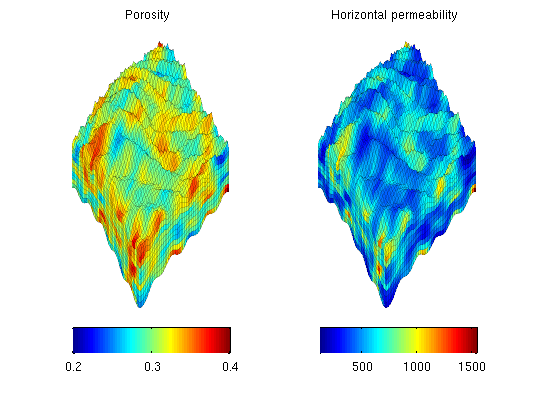In this example we consider a synthetic sloping aquifier with heterogeneous petrophysical parameters that satisfy a Carman-Kozeny relation.
Contents
Top and bottom surfaces
The topography of the top surface and the geological layers in the model is generated by combining the membrane function (Matlab logo) and a sinusoidal surface with random perturbations.
clear, clc m = 25; n = 10; [x,y]=meshgrid(0:2*m); T = 2 - 3*membrane(1,m) - 0.07*(x+y) - 0.3*sin(pi*x/12)*sin(pi*y/7) ... - 0.25*sin(pi*(x+y)/5) - 0.25*sin(pi*(x.*y)/100) - 0.3*rand(size(x)); B = 2 - 3*membrane(1,m) - 0.09*(x+y) - 0.3*sin(pi*x/15).*sin(pi*y/8) ... - 0.25*sin(pi*(x+y+5)/5) - 0.25*sin(pi*(x.*y)/80) + 4; clf mesh(x,y,T); hold on, mesh(x,y,B), hold off set(gca,'zdir','reverse'); title('Top and bottom surface'); drawnow;

3D grid
The layers in the 3D grid are interpolated between the values of the top and bottom surfaces, before we scale and translate the whole grid to suitable dimensions.
G = tensorGrid(0:2*m,0:2*m,0:n); num = prod(G.cartDims(1:2)+1); for k=1:n+1 G.nodes.coords((1:num)+(k-1)*num,3) = T(:) + (k-1)/n*(B(:)-T(:)); end clear x y T B; % G.nodes.coords(:,1:2) = G.nodes.coords(:,1:2)*2e2; G.nodes.coords(:,3) = G.nodes.coords(:,3)*15+1000; G = computeGeometry(G); clf plotGrid(G); view(3), axis tight title('3D grid'); drawnow

Top-surface grid
Make the hybrid grid structure that is uses in VE simulations and plot it slightly above the true top surface
[Gt, G] = topSurfaceGrid(G); z = Gt.nodes.z; Gt.nodes.z = 0.995*z; plotGrid(Gt,'FaceColor','b'); Gt.nodes.z = z; clear z; axis tight title('3D grid with top surface'); drawnow

Petrophysical parameters
We generate porosity as a Gausiann random field and then compute the permeability using a Carman-Kozeny relationship. The permeability in the vertical direction is set to 10% of the lateral permeability.
p = gaussianField(G.cartDims, [0.2 0.4], [11 5 3], 2.5); K = p.^3.*(1e-5)^2./(0.81*72*(1-p).^2); rock.poro = p(G.cells.indexMap); rock.perm = 5*K(G.cells.indexMap); rock2D = averageRock(rock, Gt); clf subplot(1,2,1), plotCellData(G,rock.poro,'EdgeColor','k','EdgeAlpha',0.1); view(3), colorbar('horiz'), axis tight off title('Porosity'); subplot(1,2,2); plotCellData(G,convertTo(rock.perm(:,1), milli*darcy),... 'EdgeColor','k','EdgeAlpha',0.1); view(3), colorbar('horiz'), axis tight off title('Horizontal permeability'); clear p K; drawnow

Find pressure boundary
Setting boundary conditions is unfortunately a manual process and may require some fiddling with indices, as shown in the code below. Here, we need to identify all parts of the outer boundary that are open so that we later can set an appropriate hydrostatic condition. No-flow boundaries need not be set.
% Boundary in 3D grid (works only for hexahedral grids) i = any(G.faces.neighbors==0,2); % find all outer faces I = i(G.cells.faces(:,1)); % vector of all faces of all cells, true if outer j = false(6,1); % mask, cells can at most have 6 faces j(1:4)=true; % extract east, west, north, south J = j(G.cells.faces(:,2)); % vector of faces per cell, true if E,W,N,S bcIx = G.cells.faces(I & J, 1); clf, subplot(2,1,1) plotCellData(G, G.cells.centroids(:,3), ... 'FaceAlpha', 0.5, 'EdgeColor','k', 'EdgeAlpha', 0.1) plotFaces(G, bcIx, 'g'); view(-7,60), axis tight, title('3D grid'); % Boundary in 2D grid i = any(Gt.faces.neighbors==0, 2); % find all outer faces I = i(Gt.cells.faces(:,1)); % vector of all faces of all cells, true if outer j = false(6,1); % mask, cells can at most have 6 faces, j(1:4)=true; % extract east, west, north, south J = j(Gt.cells.faces(:,2)); % vector of faces per cell, true if E,W,N,S bcIxVE = Gt.cells.faces(I & J, 1); subplot(2,1,2) plotCellData(Gt, Gt.cells.z, ... 'FaceAlpha', 0.5, 'EdgeColor','k', 'EdgeAlpha', 0.1) plotGrid(Gt, sum(Gt.faces.neighbors(bcIxVE,:),2), 'FaceColor', 'r') view(-7,60), axis tight, title('2D grid of top surface'); clear i j I J drawnow

Store data
disp(' Writing SlopingAquifer.mat'); save SlopingAquifer.mat G Gt rock rock2D bcIx bcIxVE
Writing SlopingAquifer.mat
